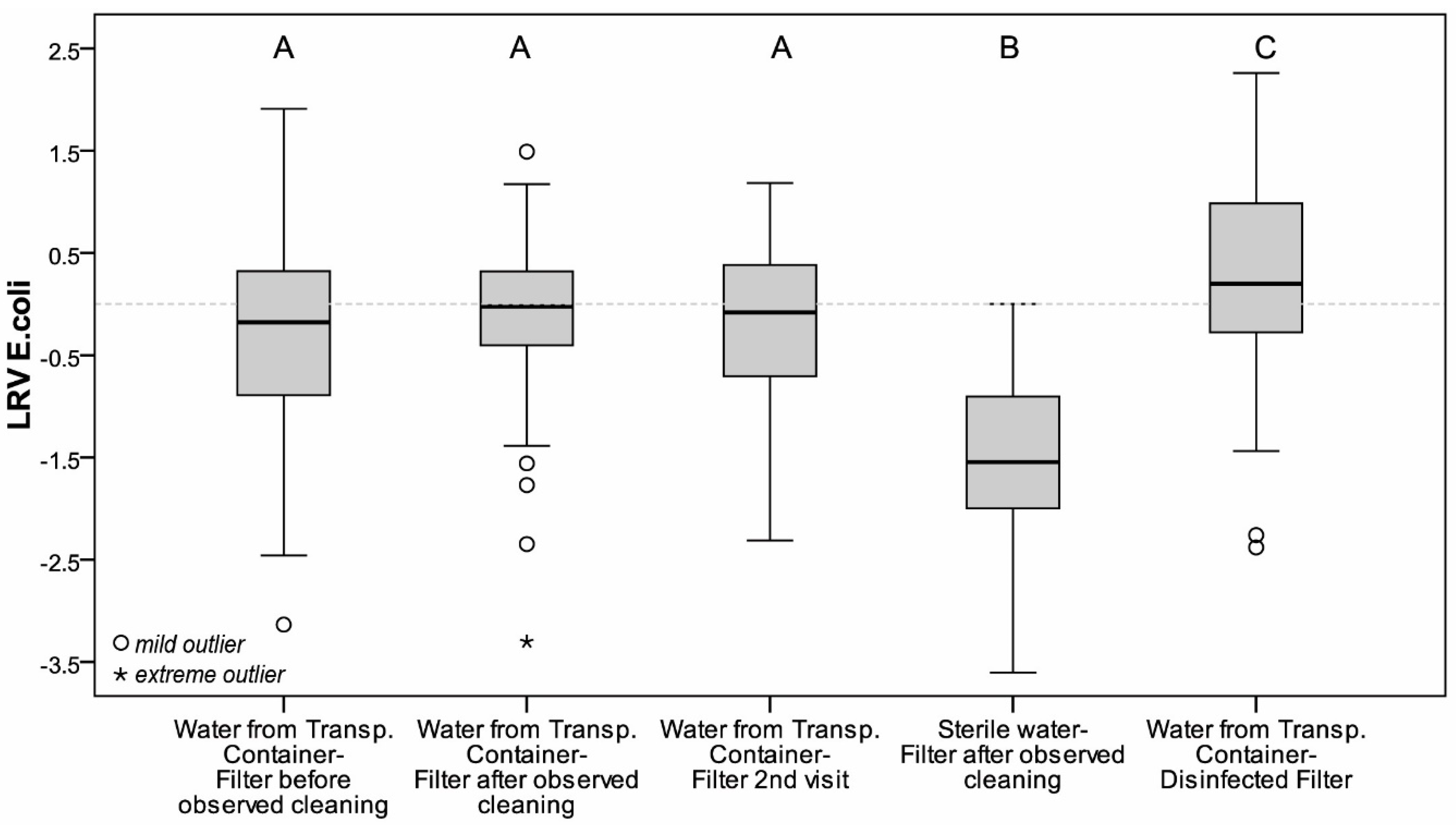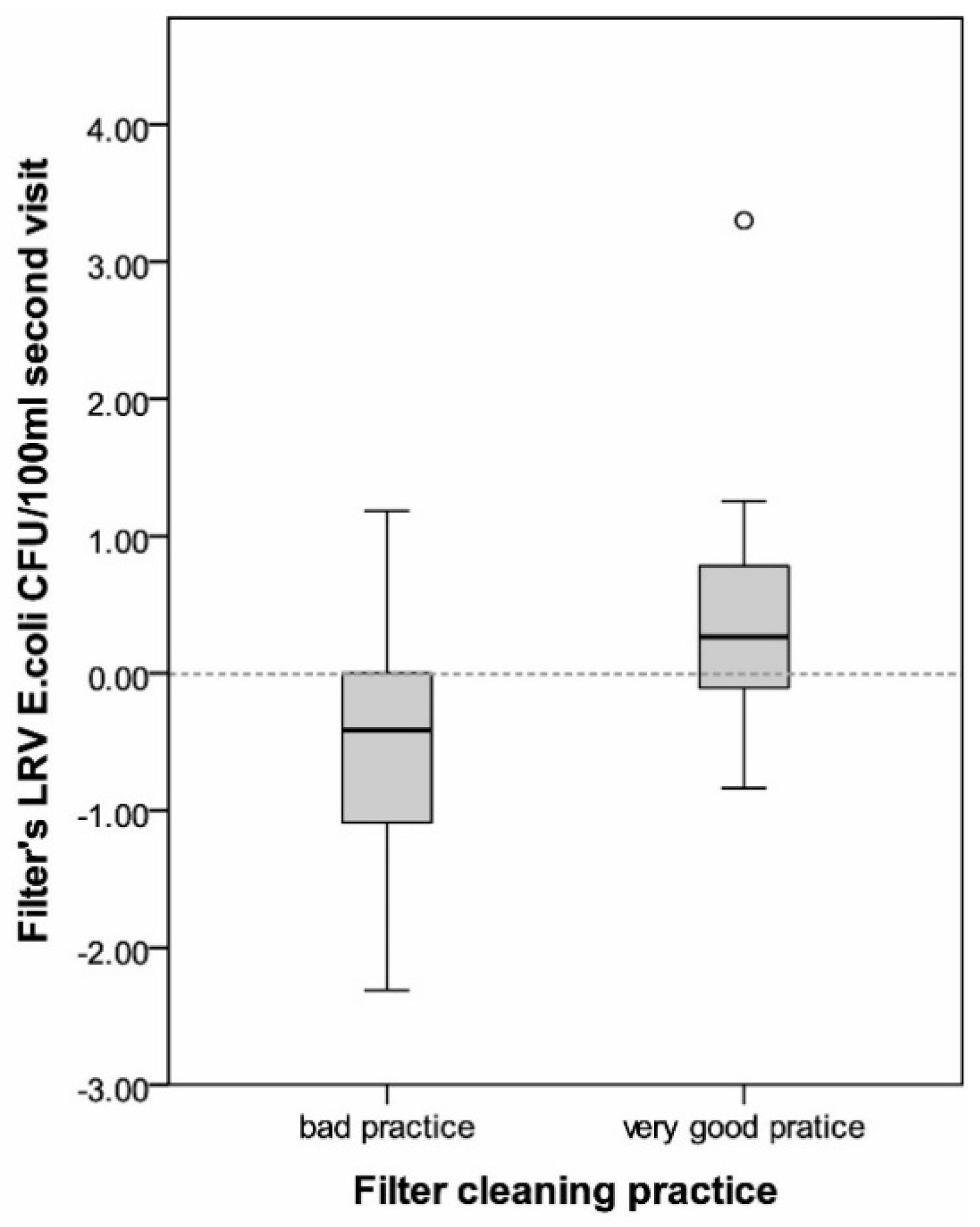From Water Source to Tap of Ceramic Filters—Factors That Influence Water Quality Between Collection and Consumption in Rural Households in Nepal
Abstract
1. Introduction
2. Materials and Methods
2.1. Context of the Study
2.2. Laboratory Evaluation of the Ceramic Water Filters
2.3. Study Design
2.4. Data Analysis
3. Results
3.1. From Source to Transport Container, First Visit
3.2. From Transport Container to Tap of Ceramic Water Filter, First Visit
3.2.1. Water Quality
3.2.2. Filter Handling
- Candles had been replaced (Pearson’s r = 0.73, p = 0.021)
- Slippers (shoes) are available in the toilet (Pearson’s r = 0.4, p = 0.011)
- Boiled water is used to clean the filter (Pearson’s r = 0.396, p = 0.009)
- Amount of water collected daily by the household (Pearson’s r = 0.347, p = 0.025
- The frequency of filter cleaning (Pearson’s r = 0.312, p = 0.044)
- Contamination level in the lower bucket of the filter (Pearson’s r = −0.564, p < 0.001)
- A soft cloth is used for the daily cleaning of the filter (Pearson’s r = −0.457, p = 0.002)
- A soft cloth is used for the daily cleaning of the transport container (Pearson’s r = −0.436, p = 0.004)
3.2.3. From Transport Container to Tap of Ceramic Water Filter, Second Visit
4. Discussion
Limitations
5. Conclusions
Supplementary Materials
Author Contributions
Funding
Acknowledgments
Conflicts of Interest
References
- WHO. Investigating in water and sanitation: Increasing access, reducing inequalities. Un-water global analysis and assessment of sanitation and drinking water. In Glaas Report; World Health Organization: Geneva, Switzerland, 2014. [Google Scholar]
- Fischer Walker, C.L.; Perin, J.; Aryee, M.J.; Boschi-Pinto, C.; Black, R.E. Diarrhea incidence in low- and middle-income countries in 1990 and 2010: A systematic review. BMC Public Health 2012, 12, 220. [Google Scholar] [CrossRef] [PubMed]
- Prüss-Ustün, A.; Bartram, J.; Clasen, T.; Colford, J.M.; Cumming, O.; Curtis, V.; Bonjour, S.; Dangour, A.D.; De France, J.; Fewtrell, L.; et al. Burden of disease from inadequate water, sanitation and hygiene in low- and middle-income settings: A retrospective analysis of data from 145 countries. Trop. Med. Int. Health 2014, 19, 894–905. [Google Scholar] [CrossRef] [PubMed]
- GON. Nepal—Demographic and Health Survey (DHS) 2016; Ministry of Health: Kathmandu, Nepal, 2017. [Google Scholar]
- Ansari, S.; Sherchand, J.B.; Parajuli, K.; Mishra, S.K.; Dahal, R.K.; Shrestha, S.; Tandukar, S.; Pokhrel, B.M. Bacterial etiology of acute diarrhea in children under five years of age. J. Nepal Health Res. Counc. 2012, 10, 218–223. [Google Scholar] [PubMed]
- Aryal, K.K.; Joshi, H.D.; Dhimal, M.; Singh, S.P.; Dhimal, B.; Dhakal, P.; Bhusal, C.L. Environmental burden of diarrhoeal diseases due to unsafe water supply and poor sanitation coverage in Nepal. J. Nepal Health Res. Counc. 2012, 10, 125–129. [Google Scholar] [PubMed]
- WHO/Unicef. Progress on Sanitation and Drinking Water: JMP 2015 Update and MDG Assessment; WHO: Geneva, Switzerland, 2015. [Google Scholar]
- GON; UNICEF. Nepal Multiple Indicator Cluster Survey 2014; Central Bureau of Statistics—National Planning Commission Secretariat, Government of Nepal: Kathmandu, Nepal, 2015.
- Brown, J.; Clasen, T. High adherence is necessary to realize health gains from water quality interventions. PLoS ONE 2012, 7. [Google Scholar] [CrossRef] [PubMed]
- Fewtrell, L.; Kaufmann, R.B.; Kay, D.; Enanoria, W.; Haller, L.; Colford, J.M., Jr. Water, sanitation, and hygiene interventions to reduce diarrhoea in less developed countries: A systematic review and meta-analysis. Lancet Infect. Dis. 2005, 5, 42–52. [Google Scholar] [CrossRef]
- Clasen, T.; Schmidt, W.P.; Rabie, T.; Roberts, I.; Cairncross, S. Interventions to improve water quality for preventing diarrhoea: Systematic review and meta-analysis. Br. Med. J. 2007, 334, 782–785. [Google Scholar] [CrossRef] [PubMed]
- Wolf, J.; Hunter, P.R.; Freeman, M.C.; Cumming, O.; Clasen, T.; Bartram, J.; Higgins, J.P.T.; Johnston, R.; Medlicott, K.; Boisson, S.; et al. Impact of drinking water, sanitation and handwashing with soap on childhood diarrhoeal disease: Updated meta-analysis and meta-regression. Trop. Med. Int. Health 2018, 23, 508–525. [Google Scholar] [CrossRef] [PubMed]
- Sobsey, M.D.; Stauber, C.E.; Casanova, L.M.; Brown, J.M.; Elliott, M.A. Point of use household drinking water filtration: A practical, effective solution for providing sustained access to safe drinking water in the developing world. Environ. Sci. Technol. 2008, 42, 4261–4267. [Google Scholar] [CrossRef] [PubMed]
- USAID. Bringing the consumer to the table. In Perceptions and Practice of Household Water Treatment Methods in Nepal; HIP, Academy for Educational Development: Washington, DC, USA, 2006. [Google Scholar]
- Clasen, T.; Boisson, S. Household-based ceramic water filters for the treatment of drinking water in disaster response: An assessment of a pilot programme in the dominican republic. Water Pract. Tech. 2006, 1. [Google Scholar] [CrossRef]
- Clasen, T.; Parra, G.G.; Boisson, S.; Collin, S. Household-based ceramic water filters for the prevention of diarrhea: A randomized, controlled trial of a pilot program in Colombia. Am. J. Trop. Med. Hyg. 2005, 73, 790–795. [Google Scholar] [CrossRef] [PubMed]
- Du Preez, M.; Conroy, R.M.; Wright, J.A.; Moyo, S.; Potgieter, N.; Gundry, S.W. Use of ceramic water filtration in the prevention of diarrheal disease: A randomized controlled trial in rural South Africa and Zimbabwe. Am. J. Trop. Med. Hyg. 2008, 79, 696–701. [Google Scholar] [CrossRef] [PubMed]
- Clasen, T.F.; Brown, J.; Collin, S.M. Preventing diarrhoea with household ceramic water filters: Assessment of a pilot project in Bolivia. Int. J. Environ. Health Res. 2006, 16, 231–239. [Google Scholar] [CrossRef] [PubMed]
- Brown, J.; Sobsey, M.D.; Loomis, D. Local drinking water filters reduce diarrheal disease in cambodia: A randomized, controlled trial of the ceramic water purifier. Am. J. Trop. Med. Hyg. 2008, 79, 394–400. [Google Scholar] [CrossRef] [PubMed]
- Morris, J.F.; Murphy, J.; Fagerli, K.; Schneeberger, C.; Jaron, P.; Moke, F.; Juma, J.; Ochieng, J.B.; Omore, R.; Roellig, D.; et al. A randomized controlled trial to assess the impact of ceramic water filters on prevention of diarrhea and cryptosporidiosis in infants and young children—Western Kenya, 2013. Am. J. Trop. Med. Hyg. 2018, 98, 1260–1268. [Google Scholar] [CrossRef] [PubMed]
- Lemons, A.; Branz, A.; Kimirei, M.; Hawkins, T.; Lantagne, D. Assessment of the quality, effectiveness, and acceptability of ceramic water filters in Tanzania. J. Water Sanit. Hyg. Dev. 2016, 6, 195. [Google Scholar] [CrossRef]
- Lange, J.; Materne, T.; Grüner, J. Do low-cost ceramic water filters improve water security in rural South Africa? Drink Water Eng. Sci. 2016, 9, 47–55. [Google Scholar] [CrossRef]
- Brown, J.; Sobsey, M.; Proum, S. Use of Ceramic Water Filters in Cambodia; Worldbank. WSP—Field Note. Available online: http://www.wsp.org (accessed on 30 October 2018).
- Mellor, J.; Abebe, L.; Ehdaie, B.; Dillingham, R.; Smith, J. Modeling the sustainability of a ceramic water filter intervention. Water Res. 2014, 49, 286–299. [Google Scholar] [CrossRef] [PubMed]
- Schärer, N. Evaluation of the Impact of Presence/Absence Tests on Safe Water Consumption; Swiss Federal Institute of Technology: Zurich, Switzerland, 2016. [Google Scholar]
- Kunwar, B.M.; Bhatta, M.; Shrestha, R.; Saladin, M. Life Span and Performance Test of Ceramic Filters. In Proceedings of the 2018 Society of Public Health Engineers, Nepal (SOPHEN) Conference, Kathmandu, Nepal, 10–12 April 2018. [Google Scholar]
- ENPHO. Study on Efficiency of Ceramic Candle Filters; Environment and Public Health Organization (ENPHO): Kathmandu, Nepal, 2016. [Google Scholar]
- Faul, F.; Erdfelder, E.; Buchner, A.; Lang, A.-G. Statistical power analyses using g*power 3.1: Tests for correlation and regression analyses. Behav. Res. Methods 2009, 41, 1149–1160. [Google Scholar] [CrossRef] [PubMed]
- Brown, J. Effectiveness of Ceramic Filtration for Drinking Water Treatment in Cambodia. PhD. Thesis, University of North Carolina, Chapel Hill, NC, USA, 2007. [Google Scholar]
- Mosler, H.-J. A systematic approach to behavior change interventions for the water and sanitation sector in developing countries: A conceptual model, a review, and a guideline. Int. J. Environ. Health Res. 2012, 22, 431–449. [Google Scholar] [CrossRef] [PubMed]
- Boisson, S.; Kiyombo, M.; Sthreshley, L.; Tumba, S.; Makambo, J.; Clasen, T. Field assessment of a novel household-based water filtration device: A randomised, placebo-controlled trial in the democratic republic of Congo. PLoS ONE 2010, 5, e12613. [Google Scholar] [CrossRef] [PubMed]
- Peletz, R.; Simuyandi, M.; Simunyama, M.; Sarenje, K.; Kelly, P.; Clasen, T. Follow-up study to assess the use and performance of household filters in Zambia. Am. J. Trop. Med. Hyg. 2013, 89, 1190–1194. [Google Scholar] [CrossRef] [PubMed]
- Murray, A.L.; Stewart, B.; Hopper, C.; Tobin, E.; Rivera, J.; Mut-Tracy, H.; Stewart, P.; Stewart, C.; Tobin, C.; Goeb, M.; et al. Laboratory efficacy and field effectiveness of hollow fiber membrane microfilters used for household water treatment in honduras. J. Water Sanit. Hyg. Dev. 2017, 7, 74–84. [Google Scholar] [CrossRef]
- Meierhofer, R.; Flückiger, A.C.; Gebauer, H. Do sales models influence the purchase and use of ceramic filters in rural areas of Kenya and Bolivia? J. Water Supply Res. Technol. 2015, 65, 87–102. [Google Scholar] [CrossRef]



| Model: Dependent Variable: LRV E. coli (E. coli in the Transport Container— E. coli at the Tap of the Ceramic Water Filter) | ||||
|---|---|---|---|---|
| B | SE (B) | Beta | p | |
| Use of boiled water to clean the filter | 1.19 | 0.43 | 0.300 ** | 0.009 |
| Availability of slippers (shoes) in the toilet | 0.70 | 0.29 | 0.280 * | 0.021 |
| Daily cleaning of the transport container with a soft cloth | −0.66 | 0.30 | −0.270 * | 0.037 |
| Contamination level of E. coli in lower bucket (reservoir for filtered water) | 0.00 | 0.00 | −0.300 * | 0.016 |
| Cleaning of the filter with a soft cloth | −0.58 | 0.30 | −0.24 | 0.062 |
| (Constant) | 0.08 | 0.22 | 0.718 | |
© 2018 by the authors. Licensee MDPI, Basel, Switzerland. This article is an open access article distributed under the terms and conditions of the Creative Commons Attribution (CC BY) license (http://creativecommons.org/licenses/by/4.0/).
Share and Cite
Meierhofer, R.; Bänziger, C.; Deppeler, S.; Kunwar, B.M.; Bhatta, M. From Water Source to Tap of Ceramic Filters—Factors That Influence Water Quality Between Collection and Consumption in Rural Households in Nepal. Int. J. Environ. Res. Public Health 2018, 15, 2439. https://doi.org/10.3390/ijerph15112439
Meierhofer R, Bänziger C, Deppeler S, Kunwar BM, Bhatta M. From Water Source to Tap of Ceramic Filters—Factors That Influence Water Quality Between Collection and Consumption in Rural Households in Nepal. International Journal of Environmental Research and Public Health. 2018; 15(11):2439. https://doi.org/10.3390/ijerph15112439
Chicago/Turabian StyleMeierhofer, Regula, Carola Bänziger, Sandro Deppeler, Bal Mukund Kunwar, and Madan Bhatta. 2018. "From Water Source to Tap of Ceramic Filters—Factors That Influence Water Quality Between Collection and Consumption in Rural Households in Nepal" International Journal of Environmental Research and Public Health 15, no. 11: 2439. https://doi.org/10.3390/ijerph15112439
APA StyleMeierhofer, R., Bänziger, C., Deppeler, S., Kunwar, B. M., & Bhatta, M. (2018). From Water Source to Tap of Ceramic Filters—Factors That Influence Water Quality Between Collection and Consumption in Rural Households in Nepal. International Journal of Environmental Research and Public Health, 15(11), 2439. https://doi.org/10.3390/ijerph15112439




